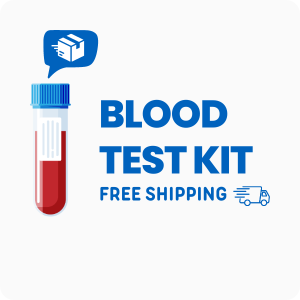Ordering the Heavy Metal Hair Analysis | Toxic & Essential Elements by Doctor’s Data
This test checks for both toxic metals and important minerals in hair, which can show long-term exposure to substances like lead, mercury, and arsenic. It also helps find imbalances in minerals such as zinc, copper, and magnesium, which can affect how the body works. Interestingly, hair analysis can sometimes reveal past exposure to metals even when blood or urine tests no longer show them, making it useful for tracking long-term or past exposures.
Ordering this test gives you a clear picture of your body’s exposure to metals and minerals. Here are some specific benefits:
- Detects hidden exposure to heavy metals that may not show up in blood tests
- Identifies mineral imbalances that can affect energy, mood, and body function
- Helps track the effectiveness of detox or chelation protocols
- Supports monitoring for people with occupational or environmental exposure risks
- Provides a noninvasive way to check for both toxic and essential elements
Who Should Consider Hair Mineral and Metal Screening
People who have unexplained tiredness, trouble focusing, or changes in mood may benefit from this test, especially if they have been in places where metal exposure is possible. For example, someone who recently moved into an older home and started feeling more tired and forgetful might want to check for lead or other metals in their system.
Ordering this test may also be helpful in these situations:
- Living near industrial areas or old buildings
- Working in jobs with possible metal exposure, like construction or manufacturing
- Following a special diet that may lack certain minerals
- Having a family member with known metal toxicity
- Using herbal or folk remedies, as some can contain hidden metals
This test can help find out if your body has been exposed to metals or if you have mineral imbalances that could affect how you feel or function. Waiting to order this test could mean missing early signs of exposure, which may make it harder to address the problem later.
Preparing for Hair Element Testing
Fasting is not needed for this test, and you can collect your hair sample at any time of day. Always follow the instructions given by your doctor or healthcare provider to make sure your sample is collected and handled the right way.
Labs Included When Ordering Your Heavy Metal Hair Analysis | Toxic & Essential Elements by Doctor’s Data
| Test Name | Reference Range | What This Measures | Low and High Levels of Heavy Metal Hair Analysis | Toxic & Essential Elements by Doctor’s Data |
|---|---|---|---|
| Toxic Metals | |||
| Aluminum | <7.0 | Aluminum is a metal found in food, water, and some medicines. High levels can build up in the body over time. | High levels mean possible exposure from cookware, water, or antacids.
Low levels mean little or no recent exposure. |
| Antimony | <0.03 | Antimony is used in batteries and flame retardants. It can enter the body through air, water, or skin contact. | High levels mean possible contact with industrial products or contaminated water.
Low levels mean little or no recent exposure. |
| Arsenic | <0.10 | Arsenic is a toxic metal found in some foods, water, and pesticides. It can build up in the body over time. | High levels mean possible exposure from water, rice, or seafood.
Low levels mean little or no recent exposure. |
| Barium | <0.20 | Barium is used in some medical tests and industrial products. It can enter the body through water or dust. | High levels mean possible exposure from contaminated water or work environments.
Low levels mean little or no recent exposure. |
| Beryllium | <0.01 | Beryllium is found in electronics and some industries. It can be harmful if inhaled or touched often. | High levels mean possible exposure from electronics or industrial dust.
Low levels mean little or no recent exposure. |
| Bismuth | <0.10 | Bismuth is used in some medicines and cosmetics. It is less toxic than other metals but can build up with overuse. | High levels mean possible overuse of bismuth-containing products.
Low levels mean little or no recent exposure. |
| Cadmium | <0.10 | Cadmium is found in batteries, tobacco smoke, and some foods. It can build up in the body and affect organs. | High levels mean possible exposure from smoking, batteries, or contaminated food.
Low levels mean little or no recent exposure. |
| Lead | <0.50 | Lead is a toxic metal found in old paint, pipes, and some imported goods. It can affect the brain and nerves. | High levels mean possible exposure from old paint, pipes, or soil.
Low levels mean little or no recent exposure. |
| Mercury | <1.10 | Mercury is found in some fish, dental fillings, and old thermometers. It can build up in the body and affect nerves. | High levels mean possible exposure from fish, dental work, or broken thermometers.
Low levels mean little or no recent exposure. |
| Nickel | <0.30 | Nickel is used in coins, jewelry, and some foods. It can cause skin reactions and build up in the body. | High levels mean possible exposure from jewelry, coins, or food.
Low levels mean little or no recent exposure. |
| Silver | <0.10 | Silver is found in jewelry, some medicines, and water filters. It is less toxic but can build up with overuse. | High levels mean possible overuse of silver-containing products.
Low levels mean little or no recent exposure. |
| Platinum | <0.01 | Platinum is used in jewelry and some medical devices. It is rare in the environment but can build up with exposure. | High levels mean possible exposure from jewelry or medical devices.
Low levels mean little or no recent exposure. |
| Thallium | <0.01 | Thallium is a highly toxic metal found in some pesticides and industrial waste. It can build up in the body and cause nerve problems. | High levels mean possible exposure from contaminated water or industrial sources.
Low levels mean little or no recent exposure. |
| Thorium | <0.01 | Thorium is a radioactive metal found in some industrial products. It is rare but can be harmful if present. | High levels mean possible exposure from industrial or radioactive sources.
Low levels mean little or no recent exposure. |
| Tin | <0.20 | Tin is used in cans, pipes, and some plastics. It can enter the body through food or water. | High levels mean possible exposure from canned foods or pipes.
Low levels mean little or no recent exposure. |
| Titanium | <0.10 | Titanium is found in some implants, paints, and sunscreens. It is not usually toxic but can build up with overuse. | High levels mean possible exposure from implants or personal care products.
Low levels mean little or no recent exposure. |
| Uranium | <0.01 | Uranium is a radioactive metal found in some rocks and water. It is rare but can be harmful if present. | High levels mean possible exposure from contaminated water or soil.
Low levels mean little or no recent exposure. |
| Essential Elements | |||
| Boron | 0.10–3.00 | Boron helps the body use calcium and magnesium. It is important for bone and brain function. | High levels mean possible overuse of supplements or exposure from water.
Low levels mean possible bone or brain function issues. |
| Calcium | 200–2000 | Calcium is needed for bones, teeth, and muscle function. It is the most common mineral in the body. | High levels mean possible overuse of supplements or bone breakdown.
Low levels mean possible weak bones or muscle cramps. |
| Chromium | 0.10–0.50 | Chromium helps the body use sugar and fat. It is important for energy and blood sugar balance. | High levels mean possible overuse of supplements.
Low levels mean possible blood sugar or energy problems. |
| Cobalt | 0.01–0.10 | Cobalt is part of vitamin B12, which helps make red blood cells and nerves work well. | High levels mean possible overuse of supplements or exposure from metal objects.
Low levels mean possible vitamin B12 deficiency. |
| Copper | 10–30 | Copper helps make red blood cells and supports nerves and the immune system. | High levels mean possible overuse of supplements or copper pipes.
Low levels mean possible anemia or nerve problems. |
| Germanium | <0.10 | Germanium is found in some foods and supplements. It is not needed by the body but can build up with overuse. | High levels mean possible overuse of supplements.
Low levels mean little or no recent exposure. |
| Iodine | 0.25–3.00 | Iodine is needed for thyroid function and making hormones that control growth and energy. | High levels mean possible overuse of supplements or seaweed.
Low levels mean possible thyroid problems. |
| Iron | 7–25 | Iron is needed to make red blood cells and carry oxygen in the body. | High levels mean possible overuse of supplements or iron cookware.
Low levels mean possible anemia or tiredness. |
| Lithium | 0.01–0.10 | Lithium is a mineral found in water and some foods. It is sometimes used in medicine for mood balance. | High levels mean possible overuse of supplements or water sources.
Low levels mean little or no recent exposure. |
| Magnesium | 30–120 | Magnesium helps muscles, nerves, and the heart work well. It is also needed for making energy. | High levels mean possible overuse of supplements.
Low levels mean possible muscle cramps or tiredness. |
| Manganese | 0.10–0.50 | Manganese helps the body use sugar and fat and supports bone and brain function. | High levels mean possible overuse of supplements or exposure from water.
Low levels mean possible bone or brain function issues. |
| Molybdenum | 0.01–0.10 | Molybdenum helps the body break down certain amino acids and drugs. | High levels mean possible overuse of supplements.
Low levels mean possible trouble breaking down some foods or medicines. |
| Phosphorus | 70–170 | Phosphorus is needed for bones, teeth, and making energy in the body. | High levels mean possible overuse of supplements or kidney issues.
Low levels mean possible weak bones or tiredness. |
| Potassium | 50–250 | Potassium helps muscles and nerves work and keeps fluid balance in the body. | High levels mean possible overuse of supplements or kidney issues.
Low levels mean possible muscle weakness or cramps. |
| Rubidium | 0.10–1.00 | Rubidium is a trace mineral found in some foods. Its role in the body is not well understood. | High levels mean possible overuse of supplements.
Low levels mean little or no recent exposure. |
| Selenium | 0.60–2.50 | Selenium helps protect cells from damage and supports thyroid function. | High levels mean possible overuse of supplements.
Low levels mean possible thyroid or immune problems. |
| Sodium | 50–250 | Sodium helps control fluid balance and supports nerve and muscle function. | High levels mean possible overuse of salt or kidney issues.
Low levels mean possible muscle cramps or weakness. |
| Strontium | 0.10–1.00 | Strontium is found in some foods and water. It is similar to calcium and may help bone strength. | High levels mean possible overuse of supplements or water sources.
Low levels mean little or no recent exposure. |
| Sulfur | 100–500 | Sulfur is needed for making proteins and some vitamins. It helps the body detoxify chemicals. | High levels mean possible overuse of supplements.
Low levels mean possible trouble making proteins or detoxifying. |
| Vanadium | 0.01–0.10 | Vanadium is a trace mineral found in some foods. Its role in the body is not well understood. | High levels mean possible overuse of supplements.
Low levels mean little or no recent exposure. |
| Zinc | 10–20 | Zinc helps the immune system, supports growth, and helps heal wounds. | High levels mean possible overuse of supplements.
Low levels mean possible immune or growth problems. |
| Zirconium | <0.10 | Zirconium is found in some dental and medical products. It is not needed by the body but can build up with exposure. | High levels mean possible exposure from dental or medical products.
Low levels mean little or no recent exposure. |
Reference ranges may change slightly as labs update their methods or as new research becomes available. Always check your report for the most current reference values.
Heavy Metal Hair Analysis | Toxic & Essential Elements by Doctor’s Data FAQ
Is there Heavy Metal Hair Analysis | Toxic & Essential Elements by Doctor’s Data testing near me?
This is a test kit you can use at home, and you can check the draw location link at the top of the page for local collection options. If you have concerns about possible metal exposure from your environment, being able to collect your sample easily and quickly can help you get answers without delay.
How do I interpret the test results?
While your treating physician should review your results, we also offer a one-on-one test results review with our clinical team to help you understand what your results mean and what steps you can take next.
What is the cost of the test?
The price you see for this test includes standard shipping to you and return shipping to the lab, but draw fees may apply. Ordering this test can help you find out if metal exposure is affecting your body, which may help you address symptoms sooner.
How often should I retest?
It is usually recommended to retest every 4 to 6 months if you are monitoring changes in metal or mineral levels, especially if you are following a detox or chelation plan. Regular retesting helps track progress and shows if your exposure or mineral balance is improving.
How accurate is the test?
This test uses ICP-MS (Inductively Coupled Plasma Mass Spectrometry), which is a highly sensitive and specific method for measuring metals and minerals in hair, with specificity and sensitivity both above 95%. TrueHealthLabs.com partners with CLIA-certified and CAP-certified laboratories to uphold rigorous testing standards for dependable results.
Important Notes
- This kit cannot be mailed or collected in New York State.
- This test cannot be used with colored hair.
Medical Review Board
Reviewed by Jeff Donohue M.D. from Body Logic and Brady Hurst DC, CCCN. Written by True Health Lab’s team of editorial health contributors.
Disclaimer: This information is for educational purposes only and not intended as medical advice. Consult your healthcare provider for personalized guidance.
Why Customers Trust True Health Labs - What People are saying
Also rated 4.6 out of 5 based on 3452 ShopperApproved reviews- See all TrueHealthLabs.com reviews.








